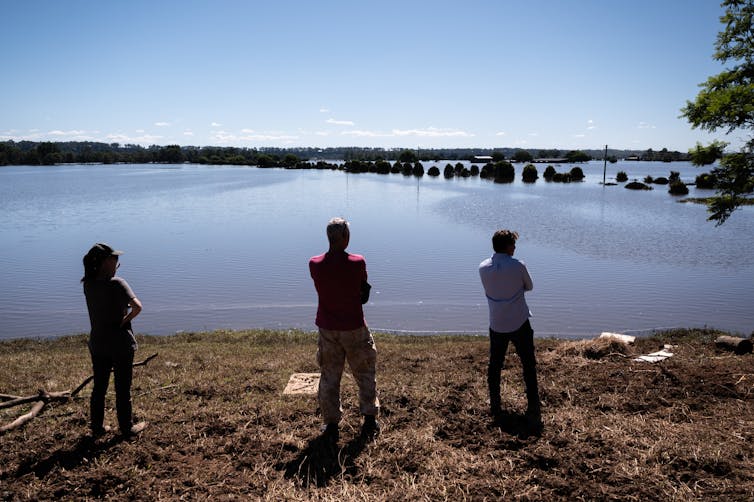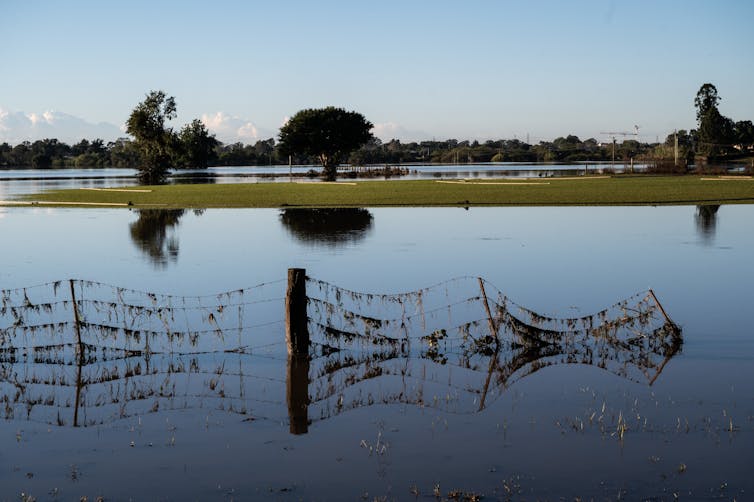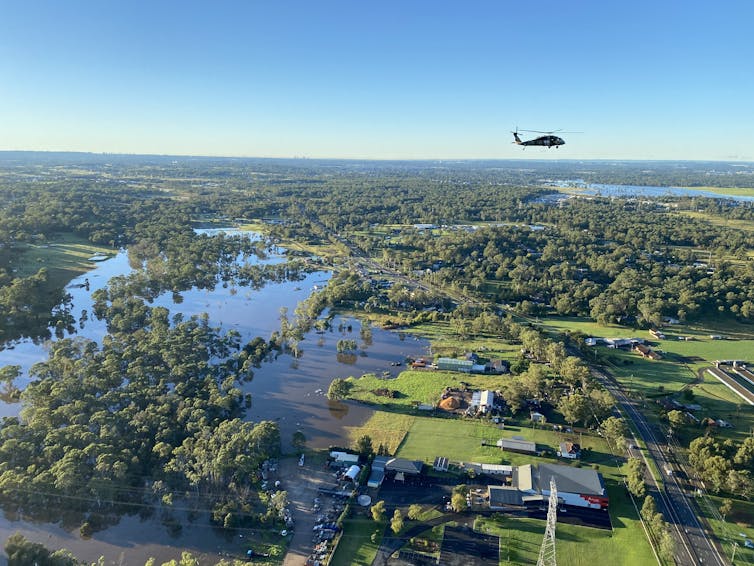Floodplains aren't separate to a river — they're an extension of it. It's time to change how we connect with them
- Written by Melissa Parsons, Senior Lecturer, Geography and Planning, University of New England
Dramatic scenes of flood damage to homes, infrastructure and livelihoods have been with us on the nightly news in recent weeks. Many will be feeling the pain for years to come, as they contend with property damage, financial catastrophe and trauma.
But what if, for a moment, we removed the humans and their structures from these tragic images — what would we see?
We would see a natural process of river expansion and contraction, of rivers doing exactly what they’re supposed to do from time to time. We’d see them exceeding what we humans have deemed to be their boundaries and depositing sediment across their floodplains. We’d see reproductive opportunities for fish, frogs, birds and trees. The floods would also enrich the soils. Floods can be catastrophic for humans, but they are a natural part of an ecosystem from which we benefit.
These scenes clearly depict the intersection of humans and nature, and it’s not working out well for either side.
Read more: 5 ways the government can clean up the Murray-Darling Basin Plan
We must envision a new way of interacting with floodplains – these brilliant social-ecological systems that are not separate to rivers but rather part of the riverine landscape.
Humans can live on and with floodplains — but the way we do that has to change.
 Humans can live on and with floodplains — but the way we do that has to change.
AAP Image/James Gourley
Humans can live on and with floodplains — but the way we do that has to change.
AAP Image/James Gourley
What is a floodplain?
Floodplains are relatively flat stretches of land located next to rivers. It helps to think of them as an extension of the river; it is natural and normal for a river to flood their adjacent plains.
Floodplains are composed of sediment the river has transported and then deposited, which makes them incredibly fertile. Flow and sediment regimes interacting over decades — or millennia — determine the physical and ecological character of floodplains, and the way they flood.
There are more than 15 generic floodplain types in Australia. Each harbours a unique set of evolutionary properties, physical features and ecosystems.
These influence the way floodwaters traverse floodplains, how long water remains on a floodplain, the velocity, turbulence and depth of floodwaters, and ecosystem responses to flooding. Floodplains are complex and highly variable.
Floodplains are also dynamic and ever-changing — and we should expect them to change even more in the coming years. Australian rivers have experienced regular periods of increased flood activity in the past 100 years.
And climate change is predicted to increase flood activity.
Read more: 5 ways the government can clean up the Murray-Darling Basin Plan
 And climate change is predicted to increase flood activity.
AAP Image/James Gourley
And climate change is predicted to increase flood activity.
AAP Image/James Gourley
Humans benefit from floodplains
Floodplains are among the most productive ecosystems on the planet – they are biodiversity hotspots.
That’s in large part due to periodic flooding between different parts of a river-floodplain system; flooding is crucial to the function of floodplains. Without floods, these floodplains wouldn’t “work” — they would not be able to deliver the ecosystem services we benefit from. Those benefits include, but are not limited to:
food grown in these fertile soils
regulation of a balanced ecosystem
cultural heritage
transportation (as floodplains are easy to build roads on)
the supply of good quality drinking water
recreation.
The economic value of floodplain ecosystem services exceed US$25,681 per hectare. Roughly 25% of global terrestrial ecosystem services come from floodplains.
Humans are drawn to live on floodplains because of their productivity. In Australia, the floodplains of the Murray Darling Basin, heavily developed for agriculture, yield more than A$10 billion annually. These floodplain ecosystems provide an estimated A$187 billion per annum from their various ecosystem services.
However, the more we interrupt floodplain processes with development, the more we diminish the supply of ecosystem services.
 The more we interrupt floodplain processes with development, the more we diminish the supply of ecosystem services.
AAP/AUSTRALIAN DEFENCE FORCE
The more we interrupt floodplain processes with development, the more we diminish the supply of ecosystem services.
AAP/AUSTRALIAN DEFENCE FORCE
The perils of living on floodplains
Putting the people back into the news footage reveals a social picture that is costly, traumatic and disruptive. The events of the past weeks have now brought into focus the perils of living on floodplains.
Humans have come up with ways to contend with this peril. Dams and levees. Land use planning. Building codes. Engineered floodscapes. Insurance. Emergency preparation systems and community engagement.
But if floodplains are a social-ecological system, where society gains great benefits but is also periodically placed at risk, which side should get the greatest policy attention? The humans or the ecosystem?
The answer is: both. But they also need to be better integrated.
Balancing the social with the ecological
Balancing the social and ecological aspects of floodplains requires a mindset change. We must combine community participation with research, resilience and adaptation to make long-term decisions about the future of these complex social-ecological systems.
If society wants to continue to derive the billions of dollars of benefits from floodplains, we need to ensure that flooding continues to occur on floodplains, and adapt to risk in imaginative and innovative ways that also protect the benefits.
Business as usual is not an option. The limitations of technocratic controls such as dams and levees should now be obvious. Time and time again, these have increased flood risk and failed to flood-proof the floodplain.
Rarely do such linear solutions solve complex problems in social-ecological systems. Linear solutions often exacerbate a problem or simply move it on to other parts of the system, creating social inequality, environmental decline and future risk.
The Australian government’s 2018 National Disaster Risk Reduction Framework sets the challenge to join up the built, social, economic and natural environments to address disaster risk in Australia.
Accepting the challenge requires a broader focus on balancing the social-ecological sides of Australia’s vast floodplains. Complexity, not linear thinking, must be embedded in the way we reimagine policy about floodplains and floods.
This requires transformative collaborations between government departments, researchers, business, and community stakeholders.
If this article has raised issues for you, or if you’re concerned about someone you know, call Lifeline on 13 11 14. This story is part of a series The Conversation is running on the nexus between disaster, disadvantage and resilience. You can read the rest of the stories here.
Authors: Melissa Parsons, Senior Lecturer, Geography and Planning, University of New England



















